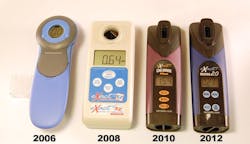A Digital Future
About the author: Andrew Roberts is assistant sales manager for Industrial Test Systems Inc. Roberts can be reached at [email protected] or 803.329.9712.
Water quality testing can be a critical part of a company’s process. Whether it is a screening method for different water quality parameters, part of a process that requires the addition or subtraction of chemicals, or even compliance monitoring for consumables and effluents, water quality testing is a major part of the quality control process.
Typically, test kits are composed of reagents/reactants, testing vials, reducing agents and color charts. The testing process involves the operator collecting a water sample to be tested, adding reagents, and either reducing the color developed with a reducing agent or comparing the color developed with a color chart. The operator then must closely estimate the quantity of specific parameters in the water.
Testing Throughout History
Water filtration methods date back more than 4,000 years. Back then, water testing was performed by taste. If the water tasted pure, it was deemed safe; if the water tasted tainted, it would be filtered through sand and rock at high temperatures and allowed to cool before being retested.
By the early 18th century, additives that react visually with water and could indicate whether the sample was consumable or not were discovered, but this was not a foolproof method. It was not until the mid-1800s that reactants were impregnated onto paper to create the first known working test strip, leading to the creation of the first modern water testing method.
Since then, the industry has come a long way in terms of water analysis. Multiple methods of visual testing, from test strips to liquid reagents to powder and tablet reagents, have been developed to improve water testing standards.
As the water quality industry grew, more parameters were added to the list of tests manufacturers made. Before long, methods became available to analyze almost any water quality parameter needed to ensure that consumable water and any other process with water as a byproduct was safe.
The Digital Age
As computers and digital processors were created, so were digital methods for water quality testing. The first machines were expensive to manufacture and keep calibrated, and were limited to only one parameter.
As the digital era expanded and the costs associated with production were lowered, digital testing methods became more accessible and more capable, opening up digital testing to more markets, such as recreational water, ponds and aquariums, and food and beverage. These new testing units usually still used a reagent or reactant, and operated by calculating the amount of light that was absorbed by the altered water sample. A digital curve would tell the testing meter what the percentage of light lost through absorption meant in parts per million, pH or the proper unit of measurement for the parameter being tested, and display the result on a digital screen. This method of testing is currently known as colorimetric or photometric analysis.
Today, multiple manufacturers make photo-meters and/or colorimeters that can test anywhere from one to 250 parameters, and range in price from less than $50 to more than $8,000. These devices are typically either handheld units for field use, or bench-top units that stay inside a testing lab and are fully self-contained when it comes to testing and displaying results.
With the development of smartphones, tablets and computers came the birth of smart digital water testing. As the devices we use for phone calls, e-mails and general digital communication get more powerful, manufacturers are able to harness the processing power already in the hands of the general public to not only increase the capabilities of water testing meters, but lower the production costs as well.
Now there is no need for a digital testing meter to have a built-in processor, as long as it can communicate with a smart device, typically through a Bluetooth or other wireless connection. All the testing instrument needs to be able to do is determine the color development created by the addition of a reagent/reactant and send this value to the smart device. From there, the smart device can process, convert and display the results.
Along with this utilization of computational power comes a multitude of other capabilities not previously available. These newfound capabilities include saving results digitally; keeping a running history of testing data; customizing the parameters needed for your industry; adding date, time and GPS location to testing; and exporting, sharing and e-mailing results instantly. This also creates accountability for the company that is in charge of providing accurate testing, as all of the aforementioned details are automatically documented, ensuring that testing was done at a specific time and location.
As the digital era continues to flourish, so will water analysis, and in turn the safety of our water, regardless of market or requirement.
Download: Here
